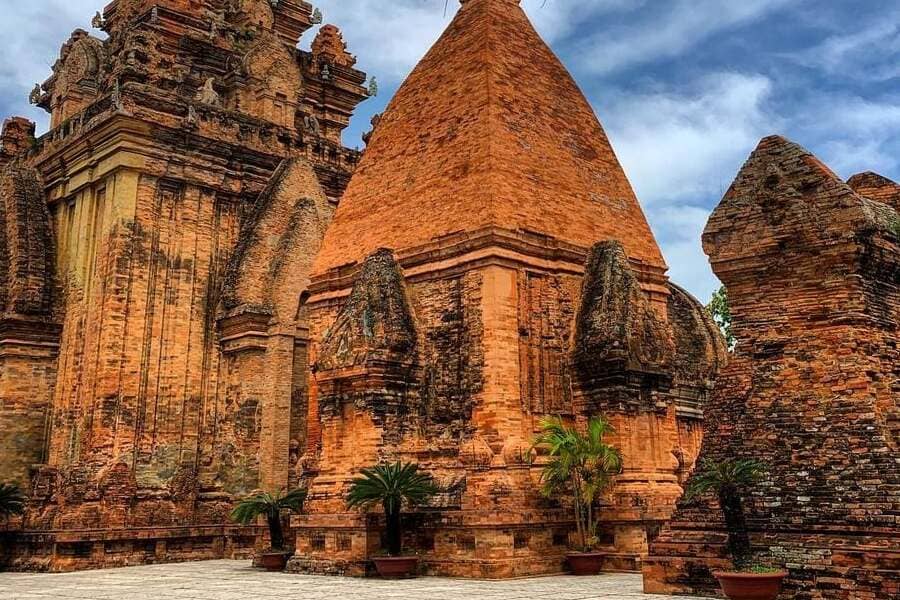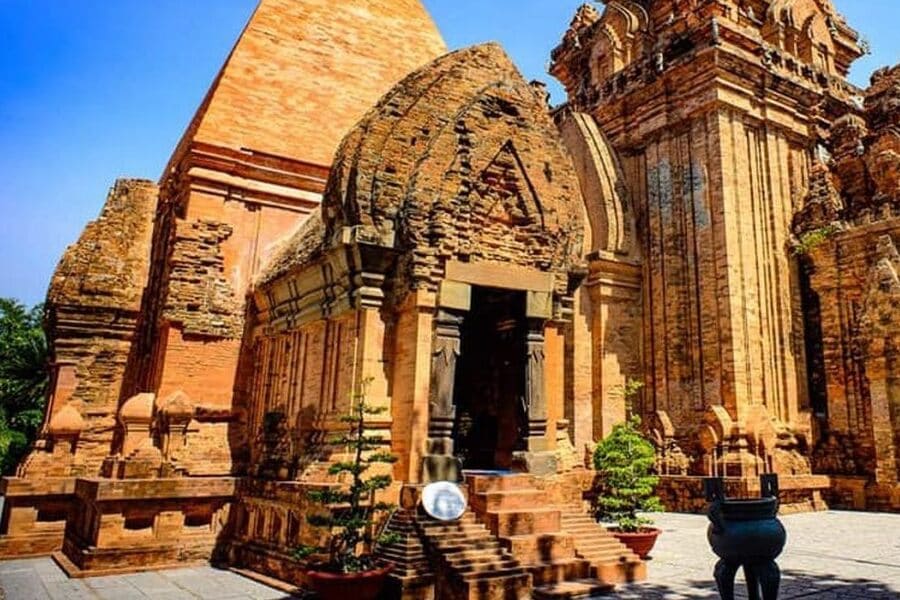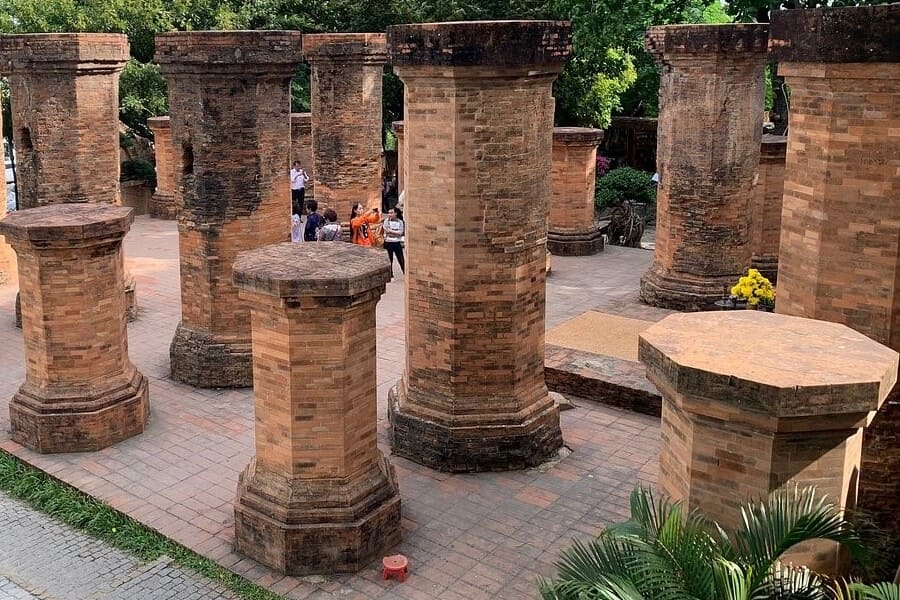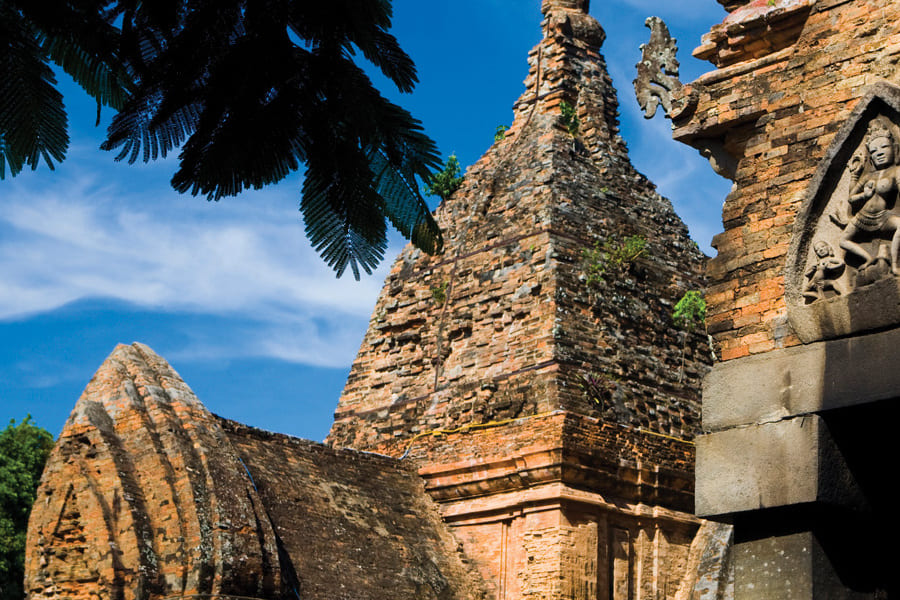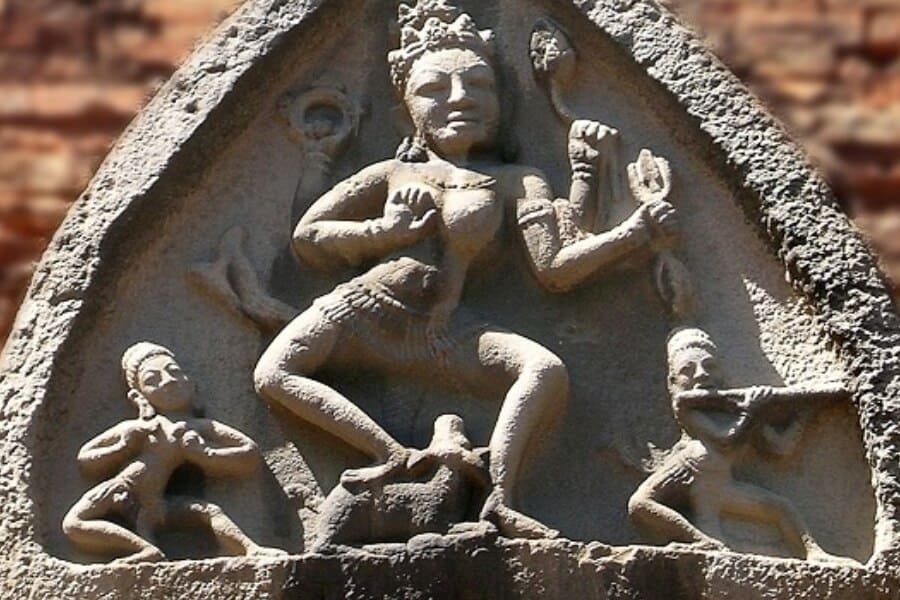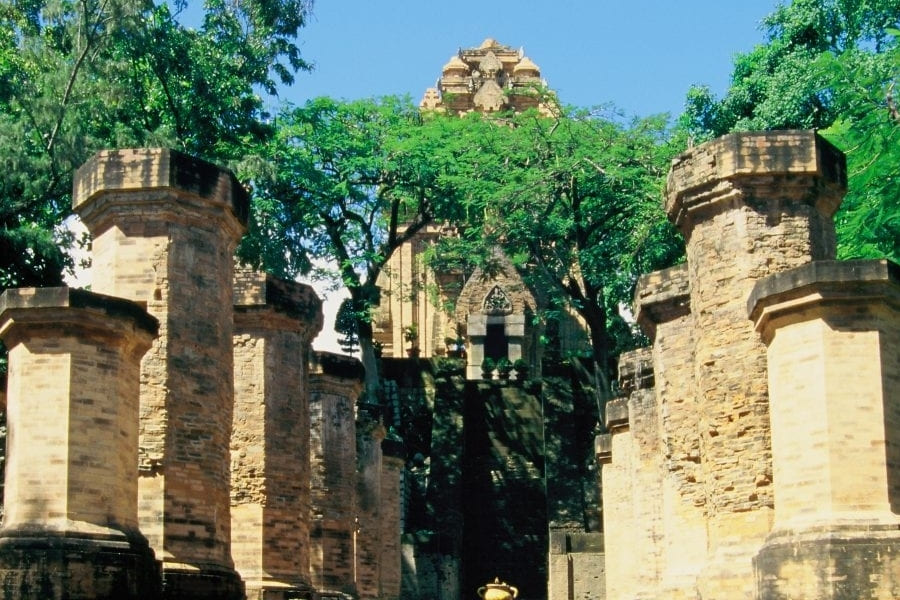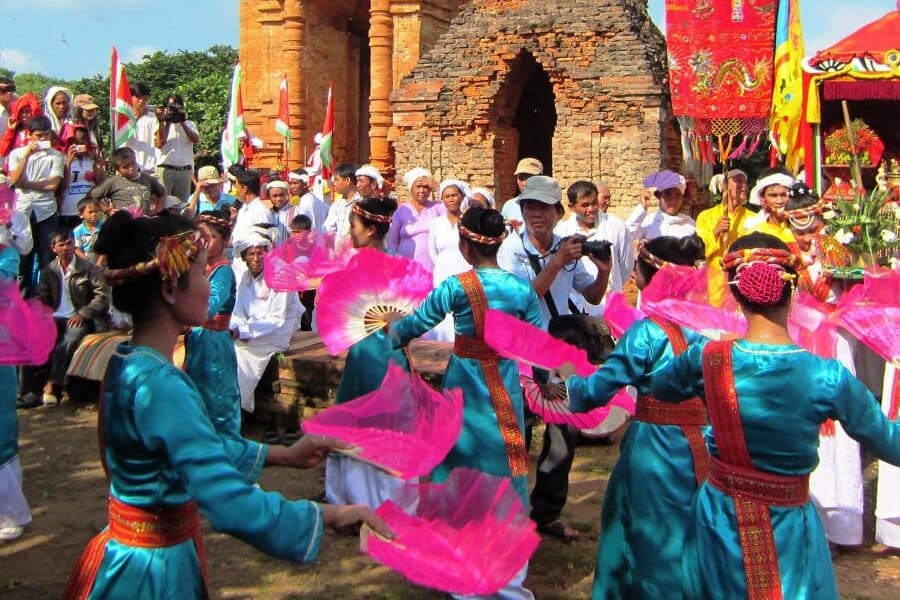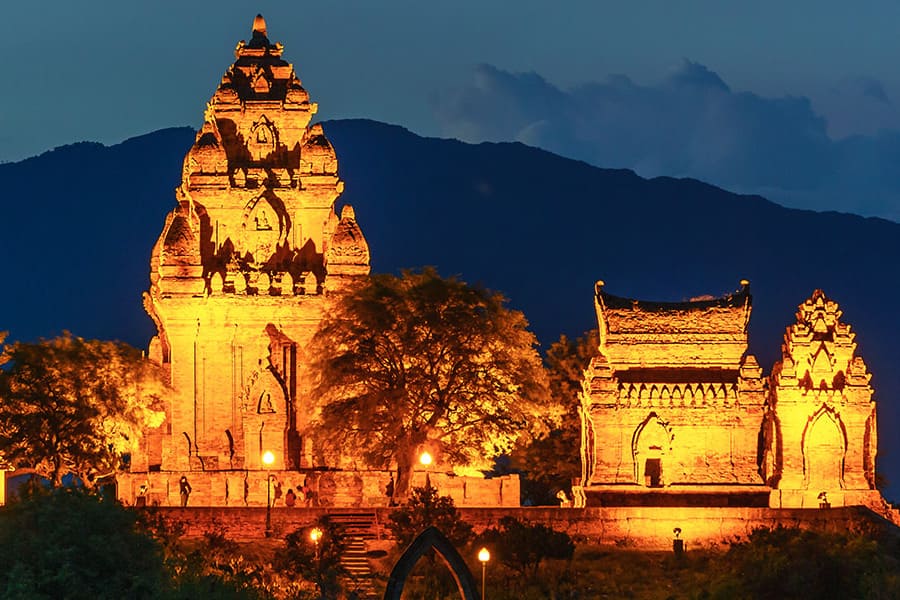Many travelers have gotten into Vietnam shore excursions with the hope of capturing unforgettable memories in the country’s beautiful landscapes. If so, The Po Nagar Cham Tower will never disappoint any travelers as it stands as an enduring mark of Cham culture, reflecting the rich heritage and spiritual depth of the Cham civilization in Vietnam.
Nestled atop a hill overlooking the serene waters of the Cai River in Nha Trang, this ancient architectural marvel dates back to the 7th to 12th centuries AD, showcasing intricate craftsmanship in brick and sandstone. Dedicated to Yan Po Nagar, the revered goddess of the Cham people, the tower complex served as a spiritual sanctuary where rituals, prayers, and offerings were made to seek blessings and protection . Today, visitors to the Po Nagar Cham Tower can immerse themselves in the symbolism of Hindu deities intricately carved into its walls, and explore the cultural significance of this UNESCO World Heritage candidate. It stands not only as a testament to Cham architectural prowess but also as a poignant reminder of Vietnam’s diverse cultural tapestry and the enduring legacy of the Cham civilization.
Introduction to Cham Po Nagar Tower
You might have heard the name somewhere, but do you know where exactly the Cham Po Nagar Tower is? Perched majestically on a hilltop overlooking the Cai River in Nha Trang, Vietnam, the Po Nagar Cham Towers are a testament to the architectural and cultural prowess of the Cham civilization. Constructed around the 10th century CE by the Cham people, these ancient towers are dedicated to Yan Po Nagar, the revered goddess of the Cham community. Belonging to the ethnic Cham minority indigenous to the central coastal regions of Vietnam, these towers stand as a symbol of both religious devotion and historical significance. Today, they remain a prominent site of cultural heritage, attracting visitors seeking to explore the intricate carvings, religious rituals, and panoramic views that define this sacred site.
The History and Development of Cham Po Nagar Tower
The Po Nagar Cham Towers, also known simply as Po Nagar, hold a rich historical significance rooted in the Cham civilization:
The towers were originally built between the 7th and 12th centuries AD by the Cham civilization, an ethnic group indigenous to central and southern Vietnam. Po Nagar was constructed as a Hindu temple complex dedicated to Yan Po Nagar, the goddess of the Cham people. It served as a center for religious worship, particularly for adherents of the Hindu religion prevalent among the Cham at the time.
Over the centuries, the complex underwent several reconstructions and expansions. The existing structures mostly date from the 8th to 13th centuries, showcasing the evolution of Cham architectural styles and religious practices during that period.
Despite periods of decline and neglect, the Po Nagar Cham Towers have survived various historical challenges and continue to be an important cultural and historical site in Vietnam. In recent decades, efforts have been made to preserve and restore the towers, ensuring their architectural integrity and historical significance are maintained for future generations.
The Po Nagar Cham Towers stand as a testament to the Cham civilization’s enduring legacy and their contributions to Vietnam’s cultural and religious heritage.
The architecture of Cham Po Nagar Tower amid Nha Trang City
The architecture of the Po Nagar Cham Towers exemplifies the intricate craftsmanship and religious symbolism of the Cham civilization. Constructed primarily from baked bricks and sandstone, the towers showcase the Cham’s advanced knowledge of materials and architectural techniques. The complex originally comprised several towers, though today only four main towers remain: the North Tower (Thap Chinh), Central Tower (Thap Nam), Small Tower (Thap Canh), and the biggest tower, which is dedicated to the goddess Yan Po Nagar.
The North Tower is notable for its sturdy construction and intricate carvings depicting various Hindu deities and mythical creatures. It serves as a prominent example of Cham craftsmanship and religious devotion. As the tallest tower in the complex, the Central Tower commands attention with its imposing presence. It is dedicated to Yan Po Nagar, the principal deity worshipped at the site, symbolizing fertility and protection. Despite its name, the Small Tower is significant for its detailed bas-reliefs and sculptures that adorn its facade. It likely served as a secondary place of worship or ceremonial space within the larger complex.The largest and most prominent tower in the complex, this structure is dedicated to Yan Po Nagar, the goddess revered by the Cham people. It features elaborate carvings depicting scenes from Hindu mythology and Cham cultural motifs.
All four towers in Nha Trang are constructed from brick and sandstone, showcasing the Cham’s mastery of these materials and their distinctive architectural style. They are adorned with intricate carvings and sculptures that depict Hindu deities, mythical creatures, and cultural motifs, reflecting the syncretic nature of Cham religious beliefs.
The towers feature a blend of Hindu and indigenous Cham architectural elements. They are adorned with intricate bas-reliefs, sculptures, and carvings depicting Hindu deities, mythological scenes, and traditional Cham motifs. Each tower is adorned with elaborate carvings that depict scenes from Hindu mythology, including the gods Shiva, Vishnu, and Ganesh, as well as sacred animals like lions and elephants.
Cham Po Nagar Tower was originally used for religious rituals and ceremonies dedicated to Yan Po Nagar, the goddess associated with fertility and the protector of the Cham people. As a UNESCO World Heritage candidate, the Po Nagar Cham Towers represents an important cultural and historical symbol, showcasing the Cham people’s religious beliefs, architectural prowess, and artistic achievements.
The architecture of the Po Nagar Cham Towers reflects the Cham civilization’s rich cultural heritage and their profound influence on the religious and artistic landscape of Vietnam.
Cham Po Nagar Tower’s Cultural and Religious Significance
Built between the 7th and 12th centuries AD, the towers served as a major religious complex dedicated primarily to Yan Po Nagar, the Cham goddess associated with fertility and the protector of the kingdom.
Cham Po Nagar Tower were a focal point for religious rituals, ceremonies, and offerings performed by Cham priests and devotees. These practices included prayers, meditation, and sacrifices aimed at seeking blessings and protection from the goddess. Reflecting the Cham’s adoption of Hinduism, the towers feature sculptures and carvings depicting Hindu deities such as Shiva, Vishnu, and Ganesh, illustrating the syncretic nature of Cham religious beliefs.
The Po Nagar Cham Towers symbolize the Cham people’s cultural identity and historical continuity in the face of various historical changes and challenges. They are a testament to the Cham’s rich artistic traditions and architectural achievements. Even today, the towers continue to attract pilgrims and visitors from across Vietnam and beyond, who come to pay homage to Yan Po Nagar and participate in traditional Cham rituals during important religious festivals and ceremonies.
As a potential UNESCO World Heritage site, the Po Nagar Cham Towers are recognized globally for their cultural and historical significance, highlighting their importance in preserving and celebrating the Cham heritage.
In essence, the Po Nagar Cham Towers are not only architectural marvels but also sacred spaces that embody the spiritual devotion, cultural resilience, and artistic legacy of the Cham civilization in Vietnam.
Special cultural event in Nha Trang Po Nagar Tower
One of the special cultural events held at Po Nagar Tower in Nha Trang is the annual Po Nagar Tower Festival. This festival typically takes place during the Cham calendar month of Thap Ba (March) and lasts for several days. It is a vibrant celebration that honors the goddess Yan Po Nagar and showcases Cham cultural traditions through various activities and rituals.
During the festival, visitors can witness traditional Cham music and dance performances, which are performed in colorful attire and accompanied by rhythmic drumming. These performances not only entertain but also convey stories and myths that are significant to Cham religious beliefs and history.
Another highlight of the festival is the offering ceremonies conducted by Cham priests and devotees. Offerings such as fruits, flowers, and incense are presented at the towers as a sign of respect and gratitude to Yan Po Nagar. This ritualistic aspect of the festival provides insight into Cham spiritual practices and the continued reverence for their ancient goddess.
The Po Nagar Tower Festival also attracts artisans who showcase their craftsmanship in traditional Cham arts, such as pottery, weaving, and sculpture. Visitors have the opportunity to purchase authentic Cham handicrafts and learn about the techniques passed down through generations.
Overall, the Po Nagar Tower Festival is not only a cultural spectacle but also a significant event that strengthens the Cham community’s cultural identity and preserves their heritage for future generations. It offers visitors a unique opportunity to immerse themselves in Cham traditions and experience the spiritual ambiance of this ancient religious site in Nha Trang.
What to do when visiting Cham Po Nagar Tower?
Making your Nha Trang shore excursions joyous than ever by visiting the Po Nagar Cham Towers and immersing in various activities and experiences. It’s worth it.
- Explore the Towers: Take your time to explore each of the remaining towers: the North Tower (Thap Chinh), Central Tower (Thap Nam), Small Tower (Thap Canh), and the main tower dedicated to Yan Po Nagar. Admire the intricate carvings, sculptures, and architectural details that reflect Cham artistic traditions.
- Learn about Cham History and Culture: Visit the on-site museum or join guided tours to learn about the history and cultural significance of the Cham people. Discover the religious practices, beliefs, and daily life of the Cham civilization through artifacts and exhibits.
- Enjoy Panoramic Views: From the towers, enjoy panoramic views of the surrounding landscape, including the Cai River and the city of Nha Trang. The hilltop location offers a serene and picturesque setting for photography and relaxation.
- Attend Cultural Performances: Check if there are cultural performances or demonstrations happening at the site. These may include traditional Cham music, dance, or rituals that offer insights into Cham cultural traditions and practices.
- Participate in Religious Observances: Respectfully observe any ongoing religious ceremonies or rituals conducted by Cham priests or devotees. Witnessing these ceremonies can provide a deeper understanding of the spiritual significance of the towers to the Cham community.
- Shop for Souvenirs: Browse local shops near the site to find souvenirs and handicrafts that reflect Cham artistry, such as traditional textiles, pottery, or jewelry. Support local artisans and take home a piece of Cham culture.
- Respect Cultural Heritage: Remember to respect the sacredness of the site by following any guidelines or rules for visitors. Dress modestly, refrain from loud noises or disruptive behavior, and avoid touching or damaging the ancient structures.
Visiting the Po Nagar Cham Towers offers a blend of historical exploration, cultural immersion, and natural beauty, making it a memorable experience for travelers interested in Vietnam’s rich cultural heritage.
How to get to Cham Po Nagar Tower from Nha Trang city center?
To get to the Po Nagar Cham Towers from Nha Trang city center, you have several options:
- Taxi or Grab: The most convenient way is to take a taxi or use a ride-hailing service like Grab. Taxis are readily available throughout Nha Trang, and the ride to the Po Nagar Cham Towers typically takes around 15-20 minutes, depending on traffic. Make sure the taxi driver uses the meter or agree on a fare beforehand.
- Motorbike or Scooter: Renting a motorbike or scooter is a popular option for those who prefer more flexibility in their schedule. Many rental shops in Nha Trang offer motorbikes for daily rental. The ride to the Po Nagar Cham Towers is straightforward and takes about 15 minutes.
- Public Bus: You can also take a local public bus from the city center to the Po Nagar Cham Towers. Look for buses heading towards Cai River or Ba Ngoi. Ask the bus driver or conductor to drop you off at the nearest stop to the towers, which is usually a short walk away.
- Bicycle or Walk: For the adventurous and those who enjoy cycling, you can rent a bicycle in Nha Trang and pedal your way to the towers. It’s a scenic route along the river and takes approximately 30-40 minutes by bike. Walking is also possible but may take longer.
- Guided Tour: Another convenient option is to join a guided tour that includes transportation to and from the Po Nagar Cham Towers. Many tour operators in Nha Trang offer half-day or full-day tours that include visits to various cultural and historical sites, including the towers.
Whichever mode of transportation you choose, visiting the Po Nagar Cham Towers from Nha Trang city center is relatively straightforward, and the journey itself can be part of the adventure, offering glimpses of local life and scenery along the way.

